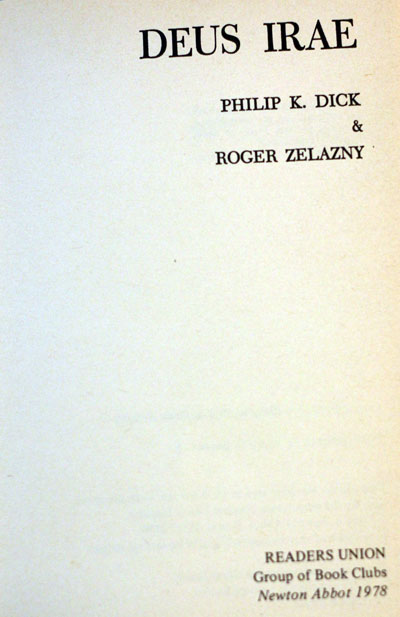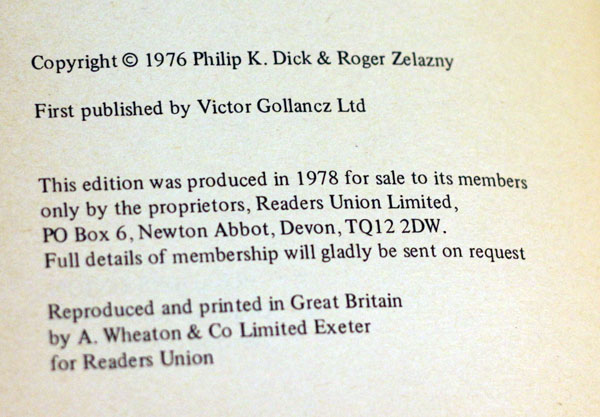Deus Irae is a post-apocalyptic science fiction novel by American authors Philip K. Dick and Roger Zelazny. It was published in 1976. Deus irae, meaning “God of wrath” in Latin, is a play on Dies Irae, meaning Day of Wrath or Judgment Day. This novel is based on Dick’s short story “The Great C.”
Dick began the book but realized he did not know enough about Christianity to finish it. He asked Ted White to collaborate on it with him, but after reviewing the manuscript White never got started. Zelazny discovered the manuscript in White’s home in early 1968, read it, then contacted Dick and agreed to work on it with him. Work proceeded sporadically over several years as each author forgot about it in turn (and Zelazny’s cat took the opportunity to urinate on the original manuscript). But they finished it quickly in the spring of 1975 when the publisher demanded the manuscript or repayment of the advance paid to Dick. The editor discovered Zelazny had sent photocopies of some pages and demanded the originals as per Doubleday’s policy; much to Zelazny’s chagrin, he had to send in the urine-stained pages and he always wondered what the editor made of them.
Plot
After 1982, the world experienced a devastating nuclear war. Fallout and radiation has caused widespread mutations to human and animal populations alike. Akin to gnosticism, there is a new messianic religion. The members of this religion, known as the Servants of Wrath or SOWs, worship the creator and detonator of the war’s ultimate weapon, Carleton Lufteufel (from the German words “Luft,” meaning “air,” and “Teufel,” meaning “Devil”), ex-chairman of the Energy Research and Development Agency of the United States of America – ERDA/USA.
In Charlotteville, there are ample debates between the Servants of Wrath and the diminishing congregations of Christians left in existence.
The Servants of Wrath faith is based on an “anger-driven” traditional perception of godhood, compared to Christian survivors, and it is from this that the book derives its name- deus irae, Latin for “God of Wrath”. Tibor McMasters is an armless, legless cyborg phocomelus artist who has been commissioned to paint a mural of Lufteufel, though nobody knows where Lufteufel lives, or what he looks like.
The Servants of Wrath leadership ask McMasters to find Lufteufel and paint his mural. En route, we learn about the absence of widespread national communications systems after the widespread destruction of nuclear warfare. McMasters and other seekers encounter mutant lizards, birds and insects who have evolved sentience, as well as the “Big C”, a decaying artificial intelligence which also survived the war, and consumes humans for their trace elements to sustain its survival.
While trying to remove the shrapnel from his forehead Lufteufel loses consciousness from loss of blood, at which point his intellectually challenged “daughter”, Alice, tries to remove some of the blood with a shirt leaving a bloody imprint. Alice keeps the shirt as it is the only remaining likeness of his face, leaving her with the only true shroud of the God of Wrath, equivalent to Catholic legends about Saint Veronica and the Shroud of Turin. Alice is later visited by Lufteufel’s “spirit” after his death. He does not speak, but Alice sees that his spirit is finally at peace after he helps Alice by “lifting the fog in her brain”, removing her disability. She is not the only human to experience a theophany related to Lufteufel’s passing, however, for another survivor has a vision of a “Palm Tree Garden” equivalent to the Judaeo-Christian Garden of Eden. This implies that Lufteufel may have been a gnostic demiurge, an evil earthbound deity which believes itself omnipotent, but whose abilities are constricted compared to “higher levels” of divinity.
However, McMasters has no knowledge of Lufteufel’s death or related alleged visions related to his death. He is tricked by his (Christian) companion Pete into using an elderly dying alcoholic vagrant for the likeness of Lufteufel for the commissioned church mural, which is prominently featured in leading Servants of Wrath institutions. The mural’s survival is a tacit argument that religious belief is often based on mythological accretions, which may not be valid interpretations of decisive events in the history of that faith.
– from wikipedia.




